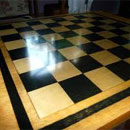Polyurethane (PU) Polish: Users' Experience, feedback and reviews |
| | Polyurethane (PU) Polish |  |
|
|
|
| User Experience |
Read User Experience, Comment, Feedback here and share your own thoughts about Polyurethane (PU) Polish.
Regards.
GharExpert Support Team |
|
|
|
|
| Type | | There are two different types of polyurethane polishes, water-based and solvent-based. Both leave a strong protective coat on the wood. PU polish is comparatively expensive compared to Melamine based polish and carpenters prefer this polish as it can give superior shining in shorter time using less labour. The PU polish is available in multiple stains that help getting the desired shade of wood. You can choose from the shades of teak, mahogany finishing, natural veneer style or other shades available. For exterior and interior application, there are different wood stains in the market so make sure you pick the right stain for the application. |
| Raw Material | | A variety of raw materials are used to produce polyurethanes. These include monomers, prepolymers, stabilizers which protect the integrity of the polymer, and colorants. |
| Implementation Raw Material | To apply a PU polish , start by sanding the wood. - FOR best polish results start by sanding the wood with a sandpaper and dust it off. While doing the sandpaper, ask the painter to rub along the grain of wood and not against it.
- Vacuum or wipe the wood to remove all dust and lint from the surface.
- Apply a thin coat of polyurethane and allow it to cure.
- Water-based polyurethane typically takes around one hour to dry, although humidity will increase this time.
- Solvent-based polyurethane needs around four hours to dry.
- Repeat the sanding, cleaning and application step at least three more times.
- For the final application of polyurethane, sand the piece with wet and dry paper.
- After the final coat of polyurethane has dried, buff the wood with a buffing wheel.
- Whether your polyurethane finishes are water- or solvent-based, this process will leave you with a high-gloss finish.
|
| Advantages | PU polish can give good finish in a shorter time. - Both water-based and solvent-based polyurethane finishes can provide a beautiful finish in matt, glossy or satin style.
- Water based Polyurethane is the most environmentally friendly finish.
- It is odorless and quick drying.
- It reduces the maintenance requirement in a furniture item as it creates a surface that has excellent resistance to scratches and moisture.
- Water base polyurethane is available in commercial and domestic quality depending on the durability required.
- Solvent-based polyurethane finishes are the older and more established form of finish.
|
| Disadvantages | - The main disadvantage with this PU polish is the higher cost of the product.
- In solvent-based, the fumes are generated while the polish is applied so it is important to work in a well-ventilated area and the area will not be usable till the fumes are cleared from the area.
- They can give a slight yellow tone to the wood finish and on extremely light colored wood, it can cause a noticeable color change.
- The PU finish darkens over time.
|
| Weather effect | | PU Polish on wood work and furniture protects the wood from all weather. |
| Time interval between TWO coats | | Allow 4-6 hours total, stretched to allow drying time for the finish. |
| Durability | - Polyurethane coatings more resistance to solvent degradation and have good impact resistance.
- These coatings are used on surfaces that require abrasion resistance, flexibility, fast curing, adhesion, and chemical resistance such as bowling alleys and dance floors.
- PU Polish surface is more durable against ultraviolet rays which present in the sun light.
- The ultraviolet radiation is to a great extent absorbed by the Polyurethane coatings and protects the surface from considerable damage.
|
|
| |
| |
|